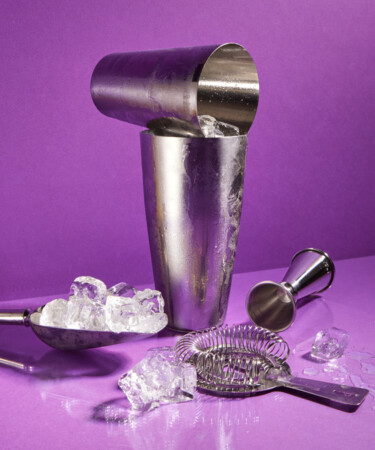We’ve all been there: You’re hanging at a friend’s place, and someone decides to make a round of drinks for everyone. They dust off the tin, assemble the ingredients, and get to shaking. Then, the limp-wristed, 30-second maraca jam commences. The cocktails come out, and they’re decent — but they would have been miles better if they had changed up their form just a bit.
With all the fat-washing, newfangled tinctures, clarification, and other derivative elements of molecular gastronomy that have crossed over to the cocktail world, we often lose sight of the more foundational elements of making a good drink. Exhibit A: shaking, and doing it with adequate force and for a reasonable amount of time. Admittedly, shaking a cocktail for too long is better than not shaking it for long enough, but you can have substantially better cocktails — and not throw your shoulder out — if you follow a few tips.
To fully understand the pitfalls of over-shaking, we consulted with Daniel O’Grady, general manager of NYC cocktail bar Lullaby.
How Long Should You Shake a Cocktail For?
When shaking a cocktail, you’re simultaneously accomplishing four goals: aeration, mixing, chilling, and dilution. It’s not really possible to over-mix or over-chill a drink, and too much aeration is hard to pull off manually with nothing other than a shaker tin. Over-dilution, though, is a common issue many home bartenders encounter, whether or not they realize it.
“The second ice hits the liquid, a timer starts,” O’Grady says. “The timer is gonna keep ticking until the cocktail is removed from the ice.” With that sense of urgency in mind, timing your shake and not getting too carried away are paramount.
“The key is to just shake really hard,” O’Grady says. “If you’re shaking appropriately hard, then you shouldn’t need to shake for longer than 10 or 12 seconds. If you’re shaking less than that, you’re probably not aerating, diluting, mixing, and chilling [the cocktail] enough.”
Then again, if you’re shaking longer than that, the risk of over-diluting the cocktail creeps in. “That’s why you shake hard,” O’Grady says. “You want to dilute, aerate, mix, and chill before that ice is touching the liquid for too long.”
While shaking with maximum force is ideal, O’Grady points out one crucial caveat, and that’s not to shake too hard right in the first few seconds.
“You don’t want to shake it immediately so hard or all of your ice will end up cracked, and then you’re just shaking this cocktail-ice slurry,” he says. You’ll want to temper the ice by sort of winding up to a faster-paced shake. “Once the ice and the liquid are at a similar temperature, that’s when you give it all you got,” O’Grady says.
And just as there’s nothing to be gained from a half-assed shake, there’s no upside to letting a drink sit in a shaker for any longer than it needs to. “The second you crack that tin, the temperature in the tin is going to rapidly trend towards room temp,” O’Grady says. “Then, the cocktail is gonna start to dilute.” Ultimately, don’t get distracted. Just make the cocktail.
How to Shake Different Cocktails
Whether a cocktail is served up, on the rocks, or with a lengthener like club soda will dictate exactly how long you’ll want to shake it for. The 10-to-12-second time frame is a good rule of thumb, but there are exceptions.
“If it’s a cocktail that’s served up, like a Daiquiri, you should shake that for about 10 seconds because it’s not gonna achieve any extra dilution [in the glass],” O’Grady says. “Something that’s gonna be served on the rocks — probably shake it for a tiny bit less. And a cocktail that’s gonna be lengthened with some kind of soda, shake it for even less.” It all comes down to adequate dilution.
Regardless of the drink, always, always shake hard, but not so fast that the ice isn’t moving all the way from one side of the shaker to the other. “That becomes especially important with egg white cocktails,” O’Grady says. “You want that ice to punch through the solids and mix it.”
If we’re going to get really technical here, there are a few different shaking styles that call for varying quantities of ice. But for the casual home bartender with a freezer stocked with standard ice cube trays, O’Grady recommends taking the smaller half of a Boston shaker and filling it with just enough ice to where a few cubes are sticking out above the rim. “That’s how it’s often measured in bars and that’s a useful way of measuring it at home.” Now that that’s settled, time to go forth and shake.
